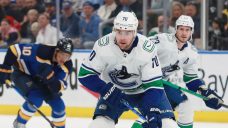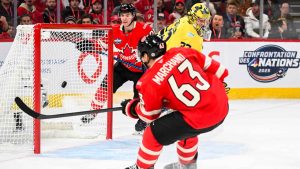VANCOUVER — Almost everything the Vancouver Canucks have said and done since the end of last season has been calculated and designed to have decks cleared and players ready for the beginning of this one.
The last-minute prep continued Tuesday when the Tanner Pearson drama ended in Vancouver with his trade to the Montreal Canadiens for backup goalie Casey DeSmith. Canucks general manager Patrik Allvin added a third-round-pick sweetener in exchange for getting a reliable National Hockey League backup and $1.45 million in savings amid Vancouver’s cap crunch.
Although likely to be unpopular in the Canucks’ dressing room, the trade also allows Pearson and the team to move on from last season’s fiasco, when what was supposed to be a four-week absence turned into a season-ending and career-threatening hand injury for the veteran winger. Pearson required multiple surgeries and the NHL Players’ Association intervened on his behalf to assess the Canucks’ medical treatment.
Not coincidentally, Tuesday’s trade came the day before players report for medicals and testing and two days before Pearson would have spoken to reporters at training camp in Victoria. He skated with teammates in Vancouver ahead of camp but declined to answer questions.
For the organization, this is another distraction avoided.
Atrocious starts, 0-5-2 last season under Bruce Boudreau and a 6-14-2 first-quarter under Travis Green in 2021-22, submarined any realistic chance the Canucks had at making the playoffs the last two years.
Boudreau and Green are now former Canuck coaches and the new guy, Rick Tocchet, demanded players return to Vancouver early to skate together, and that they be in the best shape of their careers. The first goal was achieved and we’re about to find out about the second.
Those dismal starts were preceded by disjointed, sub-optimum training camps and pre-seasons, which is why players are keenly aware that there is a lot more riding on this September than just individual positions.
A cohesive, productive, healthy training camp is everything.
“I one-hundred-percent believe in that,” Allvin told Sportsnet on the weekend. “I think that's what the players understand now, too. It's not just a mindset of: OK, we're coming in here for training camp and we'll get going. What they're showing now is that they understand that you need to be in here (early) and be ready for Day 1. On Day 1, we're going. It's about how you prepare the whole summer leading up to this point.”
Salary cap space: (minus) $2 million, pending LTIR
General manager: Patrik Allvin
Head coach: Rick Tocchet
Assistant coaches: Adam Foote, Mike Yeo, Ian Clark, Sergei Gonchar
On staff: development coaches Henrik and Daniel Sedin, skills coach Yogi Svejkovsky, video coach Dylan Crawford
Unsigned players: None
Key new additions: goalie Casey DeSmith, defencemen Carson Soucy and Ian Cole, centres Pius Suter and Teddy Blueger
CAMP BATTLES
IS THERE A THIRD-LINE CENTRE IN THE HOUSE?
Both Allvin and Tocchet stated after last season that the biggest positional need was for a third-line centre, a gap that became more obvious with the trade of Bo Horvat.
But the Canucks’ big summer spending was on defence, where Oliver Ekman-Larsson was bought out for $19.3 million US and the cap savings directed towards free agents Carson Soucy (three years at $3.25 million) and Ian Cole (one year, $3 million).
Allvin did sign free-agent centres Teddy Blueger and, in August, Pius Suter to sub-$2-million contracts. But it’s questionable whether either is really a third-line NHL pivot at this stage.
Suter managed 14 goals and 24 points for the Detroit Red Wings last season, but saw his ice time reduced by nearly three minutes (14:04 average) from the previous year and was set adrift by GM Steve Yzerman, who obviously expected more when he signed the Swiss to a two-year, $6.5-million deal in 2021.
With only four goals and an average ice time of 12:55 for Pittsburgh and Vegas, Blueger profiles as a solid fourth-liner.
Journeyman centre Sheldon Dries earned a lot of third-line time last season. Younger candidates at centre are defensively-savvy sophomore Nils Aman, who surprised everyone by making the NHL roster as an under-the-radar rookie last year before playing his way into the minors, and 20-year-old prospect Aatu Raty.
BOTTOM OF THE BLUE LINE
The top four defencemen — Quinn Hughes, Filip Hronek, Soucy and Cole — are as obvious as the fifth one, Tyler Myers. But there is a surprisingly deep competition for the sixth and seventh spots. The Canucks signed 35-year-old free agent Matt Irwin to a two-year deal, but he may start camp behind experienced minor-leaguers Guillaume Brisebois and Christian Wolanin, who both looked capable when called up after Tocchet replaced Boudreau in January.
The 14 defencemen the Canucks used last season included college free agents Cole McWard and Akito Hirose, a late-blooming 24-year-old who already appears to possess NHL smarts and poise with the puck, but is trying to turn his 170-pound frame into an NHL body. Minor-leaguer Noah Juulsen impressed blue-line coach Adam Foote during a late-season callup and will also push for playing time, as is waiver-eligible prospect Jack Rathbone.
WHAT ABOUT MIKHEYEV?
Allvin’s first big dive into free agency was signing speedy two-way winger Ilya Mikheyev to a four-year, $19-million contract in 2022. Mikheyev ticked a lot of boxes for the Canucks, and for half a season the Russian met projections while playing alongside Elias Pettersson in a key role. But he did this while playing on a torn Anterior Cruciate Ligament, suffered in the pre-season. Against Mikheyev’s wishes, the club finally shut him down on Jan. 28 so the winger’s knee could be surgically repaired in time for this season.
The problem is, he may not be ready for the start of this season. Mikheyev was not part of the daily skating sessions Canuck players organized ahead of training camp and, even if he joins the team during the pre-season, it’s unclear when he might actually be well enough to play.
His absence would create a significant hole in the lineup due to Mikheyev’s natural chemistry with linemates Pettersson and Andrei Kuzmenko and his varied tool box, which includes speed the Canucks do not possess in abundance.
Someone else may get the prime assignment of playing beside Pettersson against the opposition’s best players.
ONE IMPORTANT QUESTION
Will Canuck penalty killing be better?
Until a late-season “surge,” the Canucks had not only the worst penalty killing in the NHL but the worst penalty killing on record since the league began tracking efficiency in the 1970s. Shorthanded, the Canucks finished last at 71.6 per cent, surrendering 69 goals. As the team played itself out of the playoff race in the first half, inept penalty killing cost Vancouver at least a handful of games.
No wonder nearly all the players added in free agency, both forwards and defencemen, come with some penalty-killing acumen. It’s hard to get an accurate gauge on penalty killing in the preseason when opponents aren’t dressing full lineups. Vancouver should have the benefit from a dynamite power play, which ranked 11th last season at 22.7 per cent. But unless penalty killers get somewhere close to average, it’s unlikely this team is going to the playoffs.
PROJECTED LINEUP
Forwards
Andrei Kuzmenko-Elias Pettersson-Ilya Mikheyev
Anthony Beauvillier-J.T. Miller-Brock Boeser
Phil DiGiuseppe-Pius Suter-Conor Garland
Vasily Podkolzin-Teddy Blueger-Dakota Joshua
Defence
Quinn Hughes-Carson Soucy
Ian Cole-Filip Hronek
Guillaume Brisebois-Tyler Myers
Goaltending
Thatcher Demko
Casey DeSmith
Extras
Nils Hoglander, Christian Wolanin
Long-term injured reserve
Tucker Poolman







COMMENTS
When submitting content, please abide by our submission guidelines, and avoid posting profanity, personal attacks or harassment. Should you violate our submissions guidelines, we reserve the right to remove your comments and block your account. Sportsnet reserves the right to close a story’s comment section at any time.